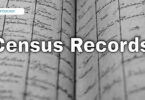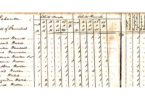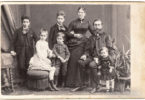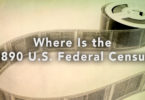The 1900 US federal census was the twelfth of its kind taken in the United States. It began on June 1, 1900, and the results determined that the population of the United States at that time was a little over seventy-five million people. This was an increase of twenty-one percent in population over the previous census, which was done in 1890. The population increase reflects the increasing number of immigrants coming to the United States at that time, usually from Europe, and with a large percentage of the newcomers being Irish.
This census also showed that the most populous city in the United States at that time was New York City, which doubled in size from the previous census thanks to the consolidation of the city with the borough of Brooklyn. New York City in 1900 was the first U.S. city to record a population of more than three million within its borders.
This census is a popular one among genealogists due to its richly detailed questions. There are questions on this census that were not on previous ones, and some questions that were ONLY asked on this particular census. The type of questions asked is of special value to genealogists, as they focus on the structure and makeup of each individual family in a way previous censuses had not. You can find plenty of information to fill in the blanks on your family tree with this valuable historical document.
These are the questions that the 1900 census asked of its respondents:
- Address
- Name of each person in the household
- The relationship of each person in the household to the head of the household
- Whether male or female
- Race or color (this is how it was worded on the census)
- The age of each person in a household
- The month and year each person in the household was born
- The marital status of each person in the household, as well as how many years they have been married as of the date they answered the census questions
- The number of children each woman on the census has had to that point, and how many of them were still living
- The place of birth of each person in the household, as well as the place of birth of their parents
- If anyone in a household was born in a foreign country, the census asks for the year they immigrated to the United States and whether they are naturalized
- Occupation of each person in the household
- The number of months that year each person in the household of working age was unemployed
- Whether anyone in the household was currently attending school
- Whether each individual in the household could speak English
- Whether a person in a household could read or write
- Whether a person in a household was a farmer or lived on a farm
- Whether the house in which a family lived was owned or rented, and if it was owned, whether it was mortgaged
As you can see, these are all important questions for a genealogist. These questions offer a genealogist a picture of what their ancestors and their households looked like on the day the census was taken at their house in 1900. Some of it is information you cannot get anywhere else. Other questions may answer questions you have had about those particular ancestors, such as where they were from or when they immigrated to the United States.
The questions can also open up new avenues of research. For example, if you did not know the date a person immigrated to the United States (but knew they were an immigrant), you can now use the date to search immigration records to find even more detailed information about that particular ancestor’s trip across the ocean to this country.
You may also find the number of children a woman in your family is listed as having had is larger than the number you knew about. You can compare this information to the number of children that women still had living in 1900, and use it to identify children you already knew about and to look for children you did not know about previously.
You can also find out the kind of education your ancestors had, including their literacy, and whether they were naturalized or could speak English (if they were naturalized, you can look for the naturalization record).
The original sheets for the enumeration of this census were microfilmed in the 1940s by the Census Bureau. When this was done, the bureau destroyed the original sheets. However, the information as it was recorded is still available on microfilm at genealogy research centers around the country, as well as at the National Archives. These microfilmed copies are also available in several places online, such as Ancestry.com and Fold3.com, where they can be searched by name, making it easy to find your ancestors in this extremely historically valuable census.
In most cases you can search online census records by first and last name, first name only, last name only, and variations of spellings. If you are not sure how a name was spelled, you can leave out the name entirely, and simply search by age, gender, and place to find your ancestor.
The information recorded in this census became publicly available in 1972, as the federal law requires a seventy-two-year waiting period before any census information becomes public. This is to protect the privacy of living people who may be mentioned in these census records. Until the invention of the Internet, it was necessary to go to a library with a genealogy department, to a museum or history center, or to the National Archives to view this census. These days, it is much easier to use this historically valuable census to research your family tree.
The 1900 census is one of the most lengthy when it comes to questions, but this is what makes it so beloved by genealogists. Use it to learn more about your family tree today.




